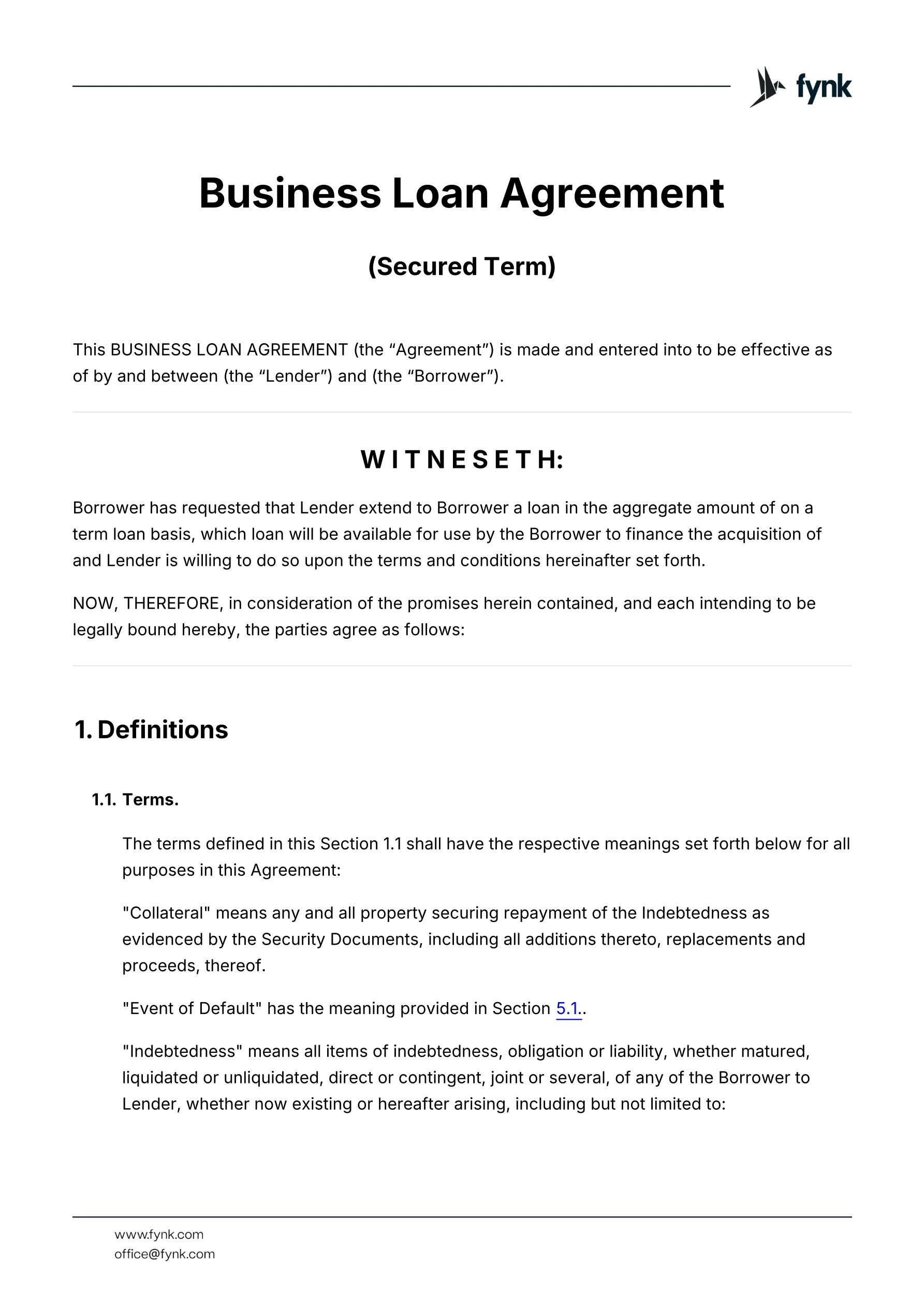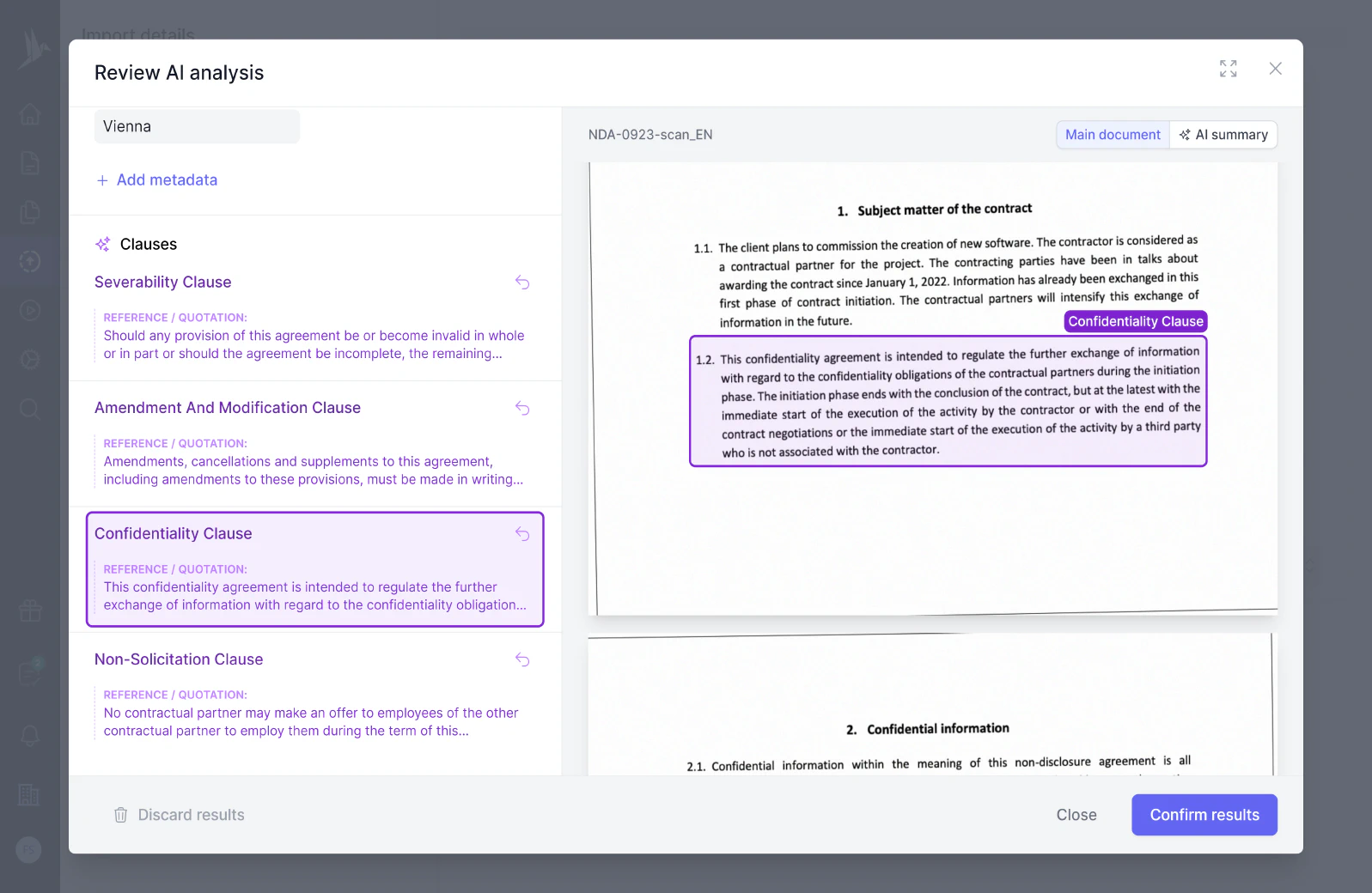
Business Loan Agreement (Acquisition and Secured Financing)
Customize a secured business loan contract covering repayment, collateral, covenants, and default terms to protect both lender and borrower.
The Definitions clause in a contract specifies the precise meanings of key terms used throughout the document, ensuring clarity and a mutual understanding between the parties involved. By outlining these terms at the beginning, it helps prevent misunderstandings and disputes over interpretations during the contract's execution.
This Confirmation is subject to, and incorporates, the definitions and provisions of the 2006 ISDA Definitions (including the Annex thereto) (the “2006 Definitions”) and the definitions and provisions of the 2002 ISDA Equity Derivatives Definitions (the “Equity Definitions”, and together with the 2006 Definitions, the “Definitions”), in each case as published by the International Swaps and Derivatives Association, Inc. (“ISDA”). In the event of any inconsistency between the 2006 Definitions and the Equity Definitions, the Equity Definitions will govern. For purposes of the Equity Definitions, each reference herein to a Warrant shall be deemed to be a reference to a Call Option or an Option, as context requires.
Market Disruption Event: Section 6.3(a) of the Equity Definitions is hereby amended (A) by deleting the words “during the one hour period that ends at the relevant Valuation Time, Latest Exercise Time, Knock-in Valuation Time or Knock-out Valuation Time, as the case may be,” in clause (ii) thereof and (B) by replacing the words “or (iii) an Early Closure.” therein with “(iii) an Early Closure, or (iv) a Regulatory Disruption.” Section 6.3(d) of the Equity Definitions is hereby amended by deleting the remainder of the provision following the term “Scheduled Closing Time” in the fourth line thereof.
The definitions and provisions contained in the 2006 ISDA Definitions (the “Swap Definitions”) and in the 2002 ISDA Equity Derivatives Definitions (the “Equity Definitions”, and together with the Swap Definitions, the “Definitions”), each as published by the International Swaps and Derivatives Association, Inc. (“ISDA”) are incorporated into this Confirmation. In the event of any inconsistency between the Swap Definitions and the Equity Definitions, the Equity Definitions will govern. In the event of any inconsistency between the Definitions and this Confirmation, this Confirmation will govern.
References in this Confirmation to “Transaction” shall be deemed to be references to “Swap Transaction” for the purposes of interpreting the Swap Definitions, and references in the Swap Definitions to “Swap Transaction” shall be deemed to be references to “Transaction” for the purposes of interpreting this Confirmation.
DEFINITIONS AND INTERPRETATION: 1.1.Terms defined in the Amended Master Definitions Agreement (a)Capitalised terms used in this Agreement and the recitals hereto and not otherwise defined herein shall have the meanings assigned to such terms in Clause 1.1 (Definitions) of the Amended Master Definitions Agreement. In the case of any inconsistency between such terms and the terms defined herein, the terms defined herein shall prevail for the purposes of this Agreement. (b)The provisions of Clause 1.2 (Construction) of the Amended Master Definitions Agreement shall apply to this Agreement as if set out in full again here, with such changes as are appropriate to fit this context.
In this Agreement: 1.“Amended Documents” means the Amended Master Definitions Agreement and the Amended Servicing Agreement. 2.“Amended Master Definitions Agreement” means the Master Definitions Agreement as amended on the Effective Date pursuant to this Agreement. 3.“Amended Servicing Agreement” means the Servicing Agreement as amended on the Effective Date pursuant to this Agreement. 4. “Effective Date” means 27 July 2021 subject to the provisions of Clause 4.1 (Effectiveness).
Definitions: AFFO Payout Ratio: Represents dividends paid within each period divided by the AFFO for that period. We report AFFO Payout Ratio because it is a widely reported measure of the performance of equity REITs, and is also used by some investors to compare our performance with other REITs. Annualized Rent: Represents annualized cash base rent (i.e. excludes tenant reimbursements, parking and other revenue) before abatements under leases commenced as of the reporting date and expiring after the reporting date (does not include 659,621 square feet with respect to signed leases not yet commenced at September 30, 2022). For our triple net office properties (in Honolulu and one single tenant building in Los Angeles), annualized rent is calculated for triple net leases by adding expense reimbursements and estimates of normal building expenses paid by tenants to base rent. Annualized Rent does not include lost rent recovered from insurance and rent for building management use. Annualized Rent includes rent for our corporate headquarters in Santa Monica. We report Annualized Rent because it is a widely reported measure of the performance of equity REITs, and is used by some investors as a means to determine tenant demand and to compare our performance and value with other REITs. We use Annualized Rent to manage and monitor the performance of our office and multifamily portfolios. Average Office Occupancy: Calculated by averaging the Occupancy Rates on the last day of the current and prior quarter and, for reporting periods longer than a quarter, by averaging the Occupancy Rates for all the quarters in the respective reported period.
Definitions: Fully Diluted Shares: Calculated according to the treasury stock method, based on our diluted outstanding stock and units in our Operating Partnership. Fund: At March 31, 2024, we owned an interest of approximately 74% in Douglas Emmett Partnership X, LP (Partnership X). During 2023, we owned an interest of approximately 34% in Partnership X, and we purchased an additional 20% interest on December 31, 2023, which increased our ownership to 54%. We also purchased an additional 20% interest on February 29, 2024, which increased our ownership to 74%. The Fund owns two office properties totaling 0.4 million square feet.
Definitions: Net Income (Loss) Per Common Share - Diluted: We calculate Net Income (Loss) Per Common Share - Diluted in accordance with GAAP by dividing the net income (loss) attributable to common stockholders for the period by the weighted average number of common shares and dilutive instruments outstanding during the period using the treasury stock method. We account for unvested Long Term Incentive Plan Unit awards that contain non-forfeitable rights to dividends as participating securities and include these securities in the computation using the two-class method. Net Operating Income (NOI): We calculate NOI as revenue less operating expenses attributable to the properties that we own and operate. We present two forms of NOI: NOI: is calculated by excluding the following from our net income (loss): general and administrative expenses, depreciation and amortization expense, other income, other expenses, income (loss) from unconsolidated Fund, interest expense, gains (losses) on sales of investments in real estate and net income (loss) attributable to noncontrolling interests.
In the context of contracts and legal documents, a definition is a specific description of a term or phrase used consistently throughout the document. Definitions clarify meanings and ensure all parties involved have a mutual understanding of key terms, reducing ambiguity and mitigating potential conflicts.
Definitions typically appear in a section of the document titled “Definitions,” where each term is explained clearly and precisely. This section helps maintain consistency in the interpretation and application of the contract, especially when complex or industry-specific terminology is involved.
You should use definitions when drafting legal documents whenever there are:
Specialized or Technical Terms: Define terms that may not be universally understood, especially in specialized or technical fields.
Multiple Interpretations: Use definitions to avoid ambiguity when a term has more than one possible interpretation.
Frequent Usage: If a term is used multiple times throughout a document, defining it ensures clarity and consistency.
Complex Contracts: In detailed contracts, definitions help structure the document and simplify particularly convoluted sections.
Using definitions correctly can prevent misunderstandings and is an essential practice in precise legal language.
To write an effective definition in a contract:
Be Clear and Concise: Qualify your term explicitly and succinctly without unnecessary complexity.
Use Simple Language: Opt for straightforward language to avoid misinterpretation.
Assign a Label: Use words like “means” or “refers to” after the term to introduce the definition.
Ensure Consistency: Make sure the defined term is used in the same way throughout the document.
Formatting: Use capitalization or italics to distinguish defined terms, e.g., “Company” means XYZ Corporation.
Example:
“Confidential Information” means any information disclosed by one party to the other in connection with this Agreement, which is marked or otherwise identified as confidential.
Definitions are common in various types of contracts, including but not limited to:
Service Agreements: These contracts often involve defined terms to clarify the scope of services, deliverables, and responsibilities of each party.
Sales Contracts: Definitions help delineate terms like “Goods,” “Seller,” and “Buyer” to ensure all parties properly understand their obligations.
Employment Contracts: Important for specifying roles, compensation, and expectations within an employment agreement.
Lease Agreements: Necessary for defining terms like “Premises,” “Tenant,” and “Landlord” to specify rights and duties.
Partnership Agreements: Helps in defining roles, profit-sharing, responsibilities, and exit clauses for partners involved.
Including a definitions section in these contracts helps bring clarity and enforceability to the terms represented therein.
These templates contain the clause you just read about.

Customize a secured business loan contract covering repayment, collateral, covenants, and default terms to protect both lender and borrower.

Define access rights, fees, and data protection terms for cloud-based software and infrastructure services.

A customizable consignment agreement template to define ownership, risk, reporting, and payment terms when goods are supplied but not yet sold.

A clear agreement defining rights, usage, compensation, and protections for licensing an individual’s name and likeness.

Restrict competitive activities, protect confidential information, and enforce post-employment obligations with a customizable non-compete.

A comprehensive operating agreement template defining LLC formation, management structure, member rights, and financial arrangements.
Dive deeper into the world of clauses and learn more about these other clauses that are used in real contracts.
Delay rentals are payments made by an oil or gas lessee to the lessor to postpone drilling operations while maintaining the lease's validity. These periodic payments allow the lessee to defer exploration or production activities without breaching the lease agreement.
The Deliverables clause outlines the specific goods, services, or outcomes that a party is obligated to provide as part of a contract. It typically includes detailed descriptions, quality standards, timelines, and acceptance criteria to ensure all parties have a clear understanding of what is expected and how performance will be evaluated.
Delivery terms are contractual provisions that specify the logistics related to the delivery of goods or services, including the time frame, location, and responsibilities for shipping and handling. These terms ensure both parties understand their obligations and help prevent disputes by outlining how and when delivery will occur.
Try our AI contract analysis and extract important clauses and information from existing contracts.
< <
Fill out the form and we will get in touch with you to give you a personal, customized demo of fynk.
Greetings!
I'm Markus, co-founder of fynk. After you've submitted the form, I'll swiftly get in touch with you.
Also, right after you submit your details, you can pick a time that works best for you for our meeting.

